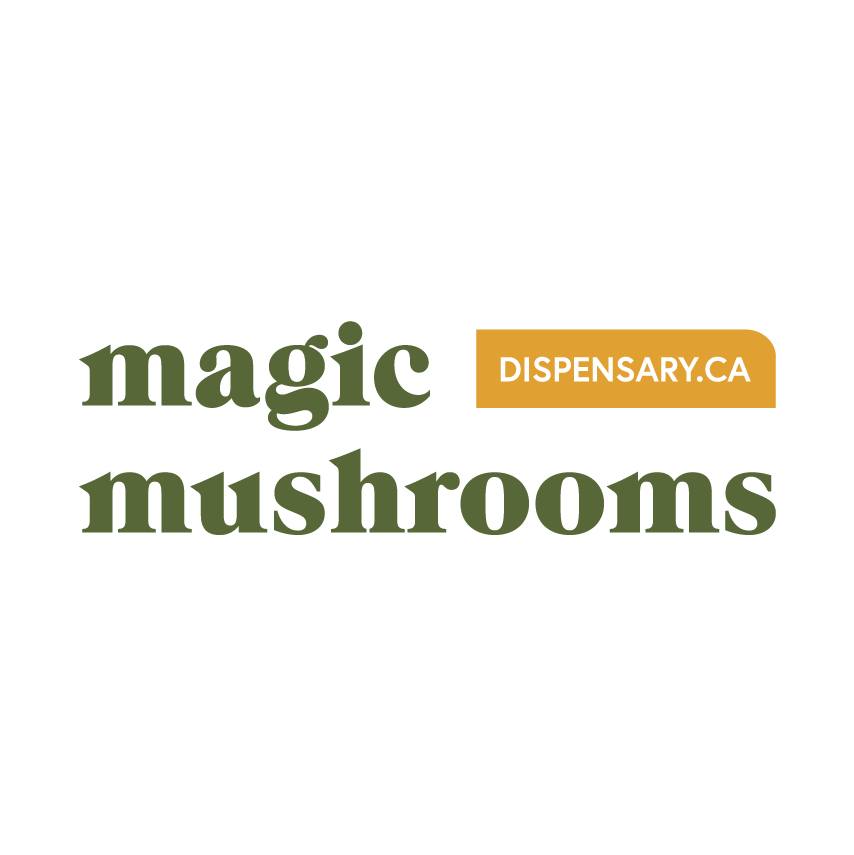Mushrooms that induce hallucinogenic experiences, often referred to as ‘magic mushrooms,’ are rich in psilocybin, a psychoactive substance that changes one’s perception, emotions, and thought processes. Varieties such as Psilocybe cubensis and Amanita muscaria are famous for their psychedelic effects. Contrary to widespread beliefs, these fungi are not intrinsically toxic or habit-forming, although improper use can have serious repercussions. It is also essential to correctly identify these mushrooms to steer clear of poisonous species. The investigational uses of psilocybin in the field of mental health therapy are opening up intriguing possibilities. To truly appreciate the complex realm of hallucinogenic mushrooms, further exploration is key to separating fact from fiction.
Key Takeaways
- Hallucinogenic mushrooms like Psilocybe cubensis contain psilocybin, a psychoactive compound that interacts with serotonin receptors in the brain.
- Misunderstandings about these mushrooms often stem from misconceptions about safety, addiction, dosage, and effects.
- Despite myths, psilocybin is not addictive, but repeated use can lead to tolerance, requiring higher doses for the same effects.
- Contrary to some beliefs, consuming hallucinogenic mushrooms carries risks, including potential poisoning from misidentification and harmful effects from increased doses.
- The therapeutic potential of psilocybin is being explored for mental health disorders, dispelling the myth that these mushrooms have no medicinal value.
History of Mushrooms That Cause Hallucinations
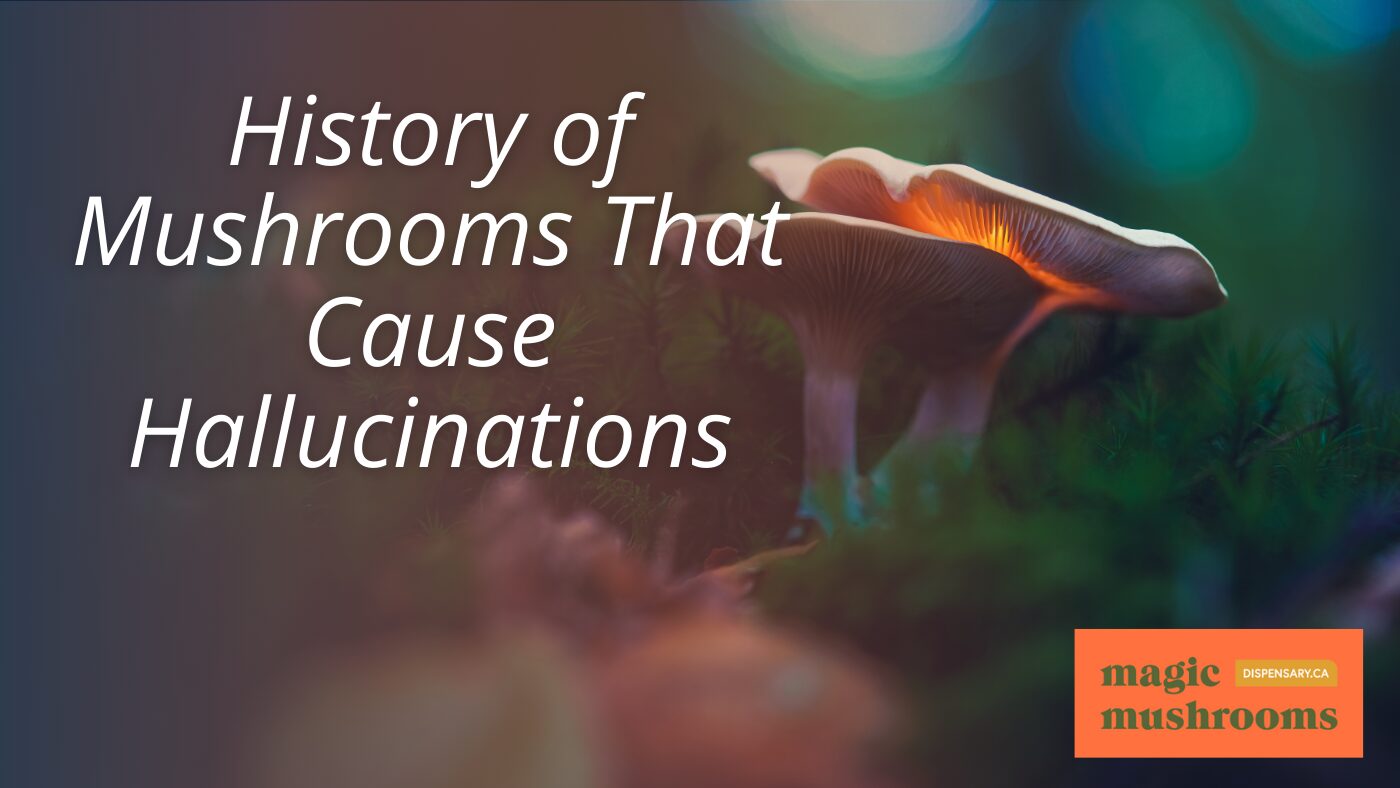
Delving into the annals of history, it becomes evident that mushrooms, which induce hallucinations, have played a significant role in various cultural and religious practices spanning thousands of years. These organic substances have been pivotal in shaping religious and spiritual experiences, transcending the bounds of physicality, and enabling the exploration of the intangible domains of consciousness.
Historical accounts of ancient civilizations, including the Central Americans and Saharan inhabitants, provide evidence of the use of hallucinogenic mushrooms for profound spiritual experiences. These societies revered these mushrooms for their capacity to induce extraordinary visions and spiritual revelations, using them as mediums to commune with supernatural entities.
Further north, in the icy landscapes of Siberia, shamans used hallucinogenic mushrooms in their rituals and ceremonies. The mushrooms were considered sacred spirits that could guide humans into the world beyond the tactile, forming a bridge between the earthly and the ethereal.
Likewise, the Aztecs, known for their intricate religious ceremonies, employed these hallucinogenic fungi as a tool for divine communication. They believed that these mushrooms opened the doors to the world of the gods, enabling them to gain wisdom and guidance.
The oldest representations of hallucinogenic mushrooms found in archaeological sites worldwide date back several millennia, further attesting to their significance in early human societies. These pictorial depictions underline these mushrooms’ enduring presence and impact on human history and culture.
In essence, hallucinogenic mushrooms have been woven into the fabric of human civilization, shaping our understanding of spirituality, consciousness, and the universe at large. They stand as evidence of humanity’s eternal quest for liberation and enlightenment.
Common Hallucinogenic Mushroom Types
Expanding on the rich historical background of hallucinogenic mushrooms, it is vital to identify the most common types of these potent fungi. The first on our list is Psilocybe cubensis, colloquially known as ‘Golden Teacher.’ This species is renowned for its psychoactive properties due to the presence of psilocybin, a naturally occurring psychedelic compound. It is noted for its golden caps and is prevalent in subtropical environments.
Another type is the iconic Amanita muscaria or fly agaric. With its unmistakable red cap and white spots, it is often depicted in popular culture. However, it is crucial to mention that this species contains muscimol, a psychoactive compound that can induce different effects than psilocybin.
Next, we have Psilocybe semilanceata or the liberty cap. This small and potent mushroom is typically found in grassy areas across North America and Europe. Its potency is attributed to its high psilocybin content.
Amanita Pantherina, also known as the Panther Cap, is another hallucinogenic mushroom. It resembles the fly agaric but is generally considered more toxic due to its higher muscimol content.
Misconceptions About Magic Mushrooms
Despite their longstanding history of traditional and spiritual use, magic mushrooms, particularly those containing the psychoactive compound psilocybin, are often misunderstood and misrepresented due to prevalent misconceptions and misinformation. This misrepresentation has, unfortunately, overshadowed the fact that not all mushrooms causing hallucinations are harmful. Some have been used safely and responsibly in therapeutic and traditional settings for centuries.
One of the most common misconceptions is that all mushrooms can induce hallucinations. However, it is precisely the magic mushrooms containing psilocybin that possess this ability. Misunderstanding of this fact often leads to unwarranted fear and stigmatization.
Another prevalent myth is that the consumption of psilocybin mushrooms is inherently dangerous. While these mushrooms are indeed classified as Schedule I drugs due to their psychoactive effects, it does not automatically translate to them being harmful when consumed responsibly and in appropriate doses. The danger arises primarily from misuse or abuse, not from the substance itself.
Furthermore, the effects of magic mushrooms are often misrepresented. They do not simply cause hallucinations but can lead to a variety of altered perceptions and sensory experiences. This complex range of effects is usually simplified and misinterpreted, contributing to the overarching misconceptions.
To dispel these myths, it is paramount to promote education and awareness about magic mushrooms. This includes understanding their history, effects, and potential risks associated with their misuse. Thorough knowledge can only help us approach the subject of magic mushrooms with informed judgment and responsible attitudes.
Psilocybin: The Active Ingredient
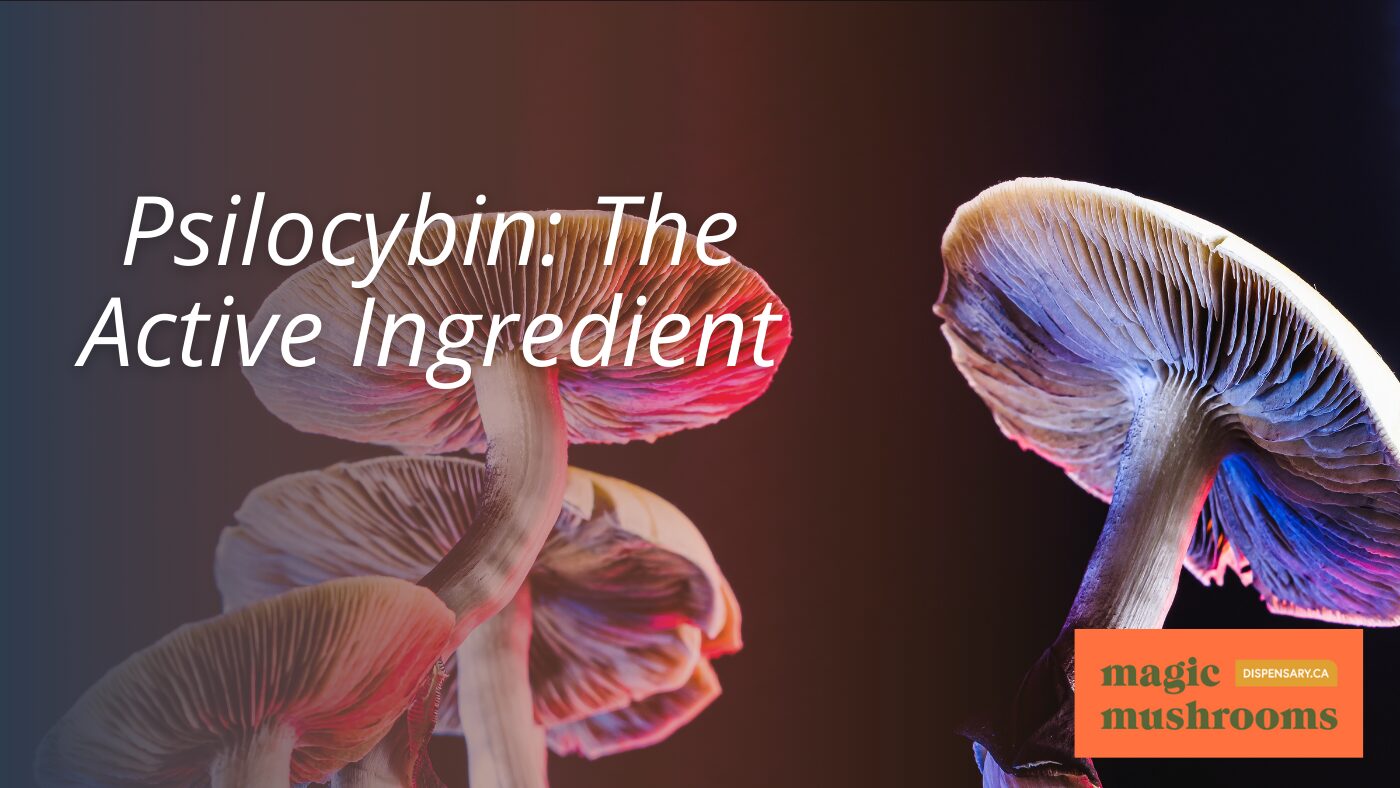
Additionally found in various magic mushrooms, psilocybin is the active compound responsible for the hallucinogenic and altered perceptual effects these fungi are known for. This naturally occurring psychedelic compound has been at the center of spiritual and therapeutic practices for centuries, with its use dating back to ancient times. The compound’s impact on human consciousness profoundly provides experiences beyond ordinary perception.
Psilocybin is classified as a Schedule I drug under the Controlled Substances Act due to its intense psychoactive effects and the potential for misuse. However, recent studies and societal shifts are challenging this classification, with many advocating for its responsible, regulated use.
Once ingested, psilocybin is converted into psilocin, which influences serotonin levels in the brain, leading to altered and enhanced sensory experiences, deep introspection, and a sense of connection. The physical characteristics of psilocybin mushrooms can vary, but they typically have long, slender stems topped with dark brown caps. The concentration of psilocybin can differ between species and even individual mushrooms, so dosage requires careful consideration.
It’s important to note that while the psychedelic experiences induced by psilocybin can be enlightening, they can also be challenging. Hence, responsible use and adequate preparation are essential. Moreover, the potential of psilocybin as a therapeutic agent is being explored, with promising results in the treatment of conditions such as depression and addiction. However, these studies are still in the early stages, and more research is required to understand this powerful compound’s implications and potential fully.
The Science Behind Mushrooms That Cause Hallucinations
Delving into the science behind hallucinogenic mushrooms reveals a fascinating interaction between the psychoactive compounds in these fungi and the human brain, leading to profound shifts in perception and consciousness. This interaction’s core is psilocybin, a compound most commonly found in ‘magic mushrooms.’
Once ingested, the body converts psilocybin into psilocin. This new compound then influences the serotonin levels in the brain, causing an array of altered perceptions. Serotonin, a neurotransmitter, is essential in regulating mood, cognition, learning, memory, and numerous physiological processes. When psilocin binds with serotonin receptors, it disrupts normal neurotransmission, leading to notable hallucinogenic effects.
The intensity of these hallucinations can vary widely from person to person and even from one experience to another. This variance is primarily due to the differing concentrations of psilocybin in different species of mushrooms. Each species contains a unique level of this psychoactive compound, which directly influences the intensity and duration of the hallucinatory experience.
Recent research ventures into the potential therapeutic uses of these mushrooms. Studies suggest that, when used responsibly and under professional guidance, psilocybin mushrooms can induce mystical experiences and profound shifts in consciousness. Such shifts have been reported to aid in tackling mental health issues like depression and anxiety, offering potential avenues for future therapeutic approaches.
Myths About Mushroom Harvesting
To promote safety and awareness, it is essential to debunk several myths surrounding the practice of harvesting wild hallucinogenic mushrooms, even though the allure of doing so may seem enticing to some. The first common misconception is that all wild mushrooms can cause hallucinations. Only specific species of mushrooms, such as those containing the compound psilocybin, can induce such experiences.
Another pervasive myth is that identifying hallucinogenic mushrooms is a simple task based on appearance alone. The truth is that proper identification necessitates expertise and a thorough understanding of mushroom taxonomy to avoid confusing hallucinogenic species with toxic look-alikes.
There’s also a false belief that harvesting hallucinogenic mushrooms from their natural habitats is both safe and legal. This misconception can lead to severe consequences, considering the potential toxicity of certain species and existing legal restrictions in many regions. Indeed, in some areas, harvesting, possessing, or consuming these mushrooms without specific authorization is illegal.
Lastly, some individuals mistakenly believe that consuming wild mushrooms in small quantities is harmless. Regardless of the amount ingested, consumption of unidentified wild mushrooms can lead to serious health risks, including toxicity and potential fatality.
The Danger of Misidentification
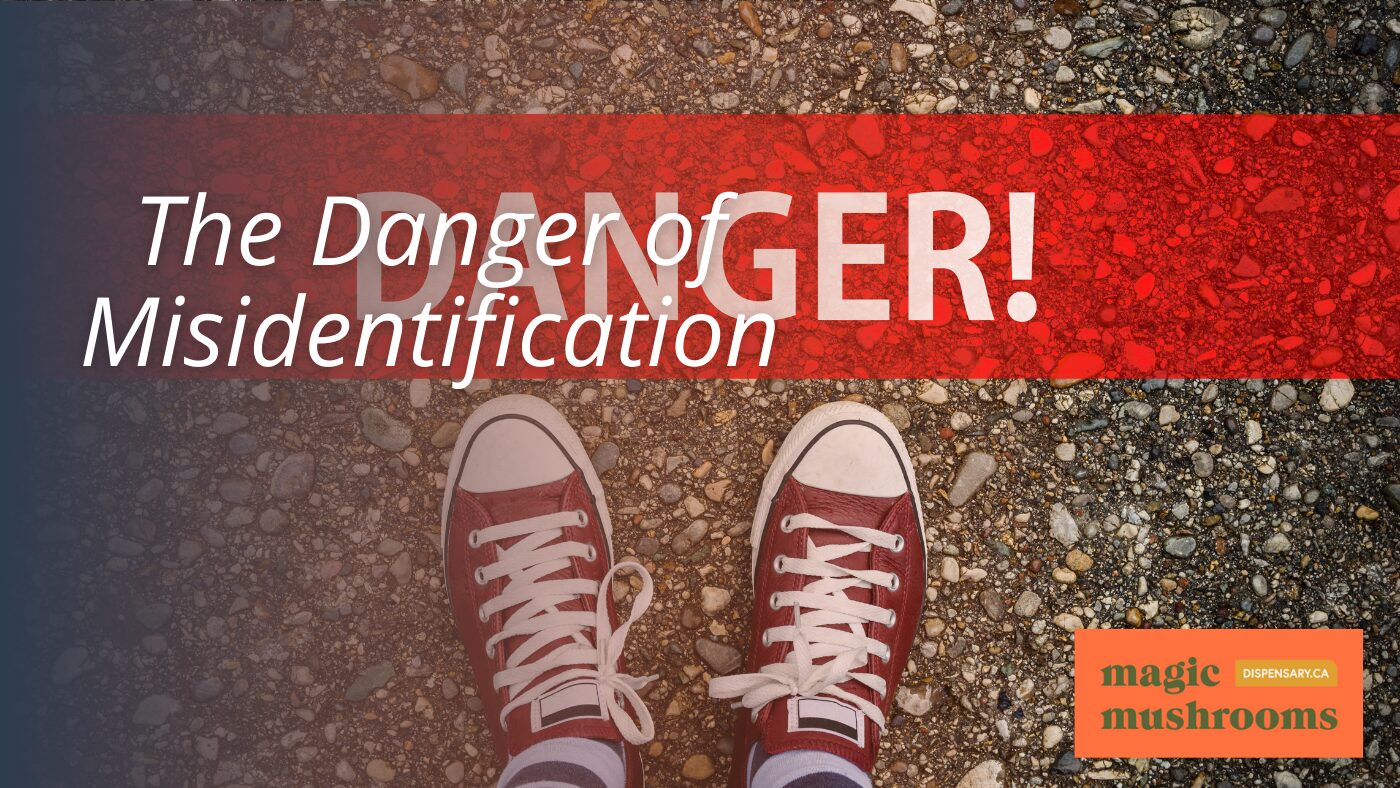
Moving beyond the domain of myths, it’s worth noting the real dangers associated with misidentifying hallucinogenic mushrooms. This mistake can lead to severe health implications, including poisoning or even death. Hallucinogenic mushrooms, such as those belonging to the Psilocybe species, have a variety of look-alikes, some of which can be deadly if ingested.
This risk of misidentification is not exhaustive, nor is it a problem confined to the uninitiated. Even seasoned foragers can mistake a toxic variety for a safe, hallucinogenic one. The similarities in appearance between certain species can be striking, with key features such as gills, cap shape, spore color, and habitat often closely mimicked by dangerous counterparts. This makes accurate identification a matter of experience and detailed and careful observation.
Accurate identification is paramount. It requires a thorough understanding of the critical features of each mushroom species and an appreciation of the potentially grave consequences of getting it wrong. Yet, while the dangers are real, they are not insurmountable. These risks can be mitigated by consulting with experienced mycologists, using reliable field guides, and approaching the identification task with the gravity it deserves.
To those yearning for liberation through exploring these natural substances, knowledge truly is power. In the world of hallucinogenic mushrooms, this power can mean the difference between a profound, enlightening experience and a potentially fatal mistake. Let this serve as a stark reminder of the importance of accurate identification and responsible use.
Hallucinogenic Mushrooms and Religion
In the domain of religion and spirituality, hallucinogenic mushrooms have been utilized for thousands of years, playing a significant role in the ceremonial practices of various cultures worldwide. The sacred use of these fungi is deeply rooted in ancestral knowledge, and their consumption is often associated with transformative spiritual experiences.
Hallucinogenic mushrooms are revered in many religions for their ability to induce altered states of consciousness. These altered states, often characterized by profound hallucinations and heightened sensory perception, are believed to provide spiritual insights, connect users with higher spheres, and enhance self-understanding. Consuming these mushrooms is often framed as a profoundly personal and transcendental journey, offering a unique pathway to spiritual discovery.
In religious contexts, hallucinogenic mushrooms are seen not merely as intoxicants but as tools for enlightenment. They serve as a bridge, connecting the mundane to the divine, the physical to the spiritual. They have been considered sacred by some indigenous tribes, who view them as a gift from nature, allowing humans to commune with the divine and the natural world.
Despite the long history of their religious use, the legal status of hallucinogenic mushrooms varies globally, reflecting societal attitudes towards their use and perceived risks. They are, however, gaining renewed interest as tools for therapeutic and spiritual exploration. As we continue to explore the potential of these fascinating organisms, it is essential to respect their cultural significance and employ them responsibly, with an understanding of their powerful effects on the human psyche.
Mushroom Use in Ancient Cultures
Delving into the pages of history, one can find intriguing evidence of mushroom use in ancient cultures, from the Central Americans to Sahara inhabitants, who revered psilocybin mushrooms for their spiritual potency. The profound experiences these mushrooms induced were often interpreted as mystical or divine encounters, shaping religious and spiritual practices.
In Siberia, shamans used hallucinogenic mushrooms in their rituals, a practice that intriguingly aligns with the iconic imagery of Santa Claus, who is often depicted with red and white colors similar to the Amanita muscaria, a type of hallucinogenic mushroom. This correlation provides compelling evidence of the deep-seated historical significance of these mushrooms in human cultures.
Ancient art also testifies to the significant role of hallucinogenic mushrooms. Rock paintings in the Sahara dating back to 7,000 to 9,000 years prominently feature mushroom-like figures, suggesting the use of psilocybin mushrooms in prehistoric times.
Despite their historical and cultural importance, hallucinogenic mushrooms have been stigmatized and driven underground due to misunderstanding and fear. Today, they are often part of the black market trade, far removed from their traditional, spiritual roots.
The active compound in these mushrooms, psilocybin, interacts with serotonin receptors in the brain, causing hallucinations. While disconcerting to some, this biochemical process was revered in ancient cultures for its capacity to bridge the mundane and the mystical.
Understanding this historical context is essential for a nuanced perspective on hallucinogenic mushrooms, liberating us from fear and opening the door to informed, respectful engagement with these potent natural substances.
Modern-Day Mushroom Usage
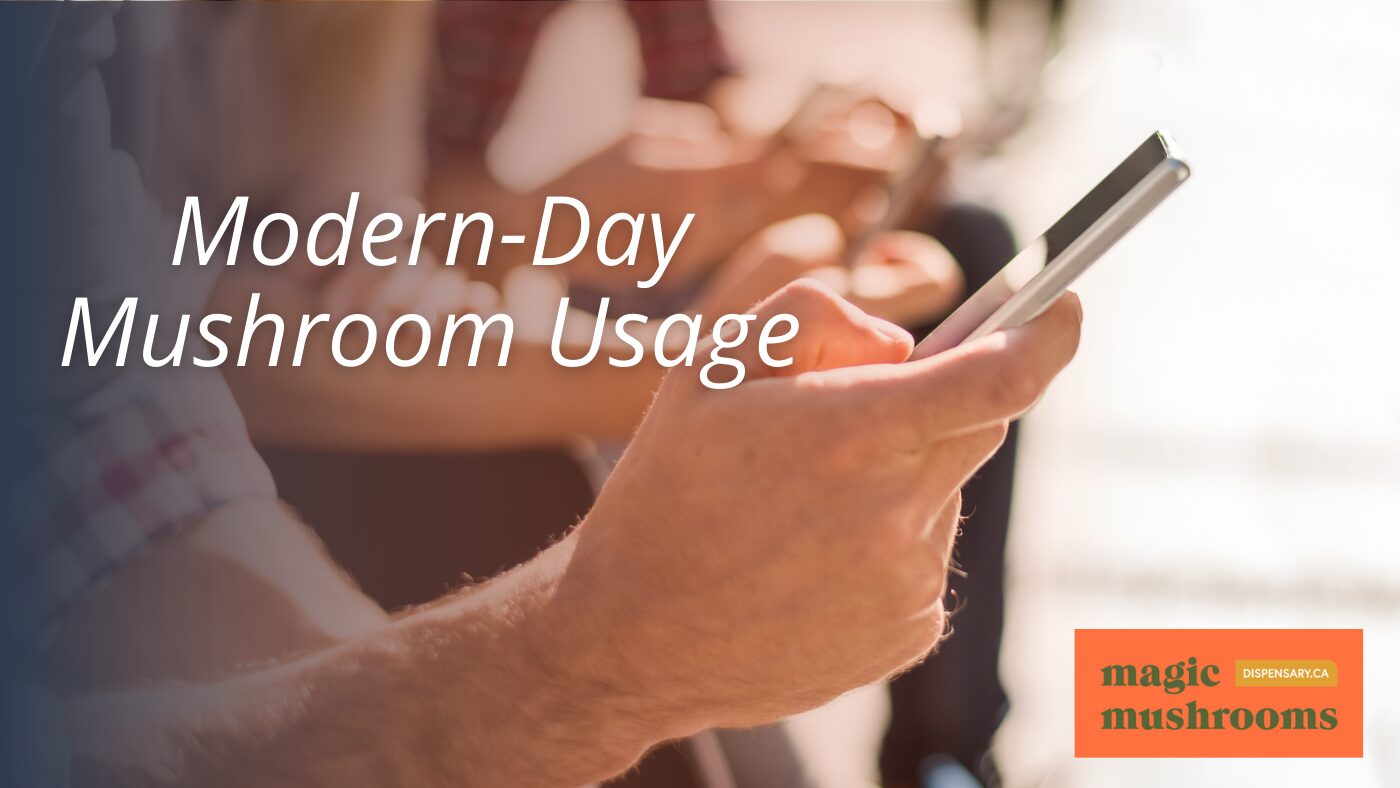
As we traverse the landscape of contemporary society, it becomes evident that the usage of psilocybin-containing mushrooms, commonly known as magic mushrooms, has surged, mainly due to their hallucinogenic effects and potential for personal growth. These mushrooms are consumed for their profound psychedelic effects, which include altered perceptions, elevations in mood, and a heightened sense of connection to oneself and the universe.
Psilocybin, the active compound in these mushrooms, interacts with serotonin receptors in the brain, leading to these hallucinatory experiences. This interaction can have various effects, from mild visual distortions to more intense spiritual experiences. The effects are not solely recreational; many users report significant personal growth and insight from their experiences, leading to a surge in popularity.
Mushrooms are used in various contexts, including recreational, spiritual, and potentially therapeutic. Recreational usage is often associated with exploring one’s consciousness and pursuing personal insight. Spiritually, some individuals use these mushrooms as a tool for meditation or for inducing a state of heightened spiritual awareness.
In the field of therapy, research is being conducted into the potential benefits of psilocybin mushrooms in treating a range of mental health disorders, including depression and PTSD. While these potential therapeutic uses are still being explored, preliminary studies suggest that psilocybin could be a powerful tool in mental health treatment.
Legalities Surrounding Magic Mushrooms
While the potential benefits and personal growth associated with magic mushrooms are increasingly recognized, it’s equally important to understand the complex legal landscape surrounding their use. Although the potential for therapeutic use of psilocybin, the active compound in magic mushrooms, is being rigorously studied and reported, it remains a controlled substance in many countries, including the United States and Canada.
Magic mushrooms are classified as Schedule I drugs under the Controlled Substances Act in the United States. This category is for substances with a high potential for abuse and no currently accepted medical use, making possession, distribution, and use without proper authorization a criminal offense. However, legal enforcement varies significantly across states, with some jurisdictions decriminalizing or reducing penalties for possessing small amounts for personal use.
In Canada, magic mushrooms are classified as Schedule III under the Controlled Drugs and Substances Act, meaning they are illegal to possess, produce, distribute, or import. However, under Health Canada’s Special Access Program, exemptions can be granted to specific patients under the guidance of a healthcare practitioner, allowing for the therapeutic use of psilocybin.
Despite the current legalities, a wave of change is rippling through the legislative landscape. Multiple campaigns are advocating for the decriminalization and potential legalization of magic mushrooms, and the exploration of their therapeutic potential continues. It’s a complex issue that requires careful consideration of possible benefits and risks, necessitating a well-informed, open-minded approach.
Myths About Mushroom Addiction
The domain of mushroom addiction is riddled with myths and misconceptions, often diverting attention from the reality that there’s little evidence of physical dependence on these hallucinogenic fungi. The belief that the consumption of these mushrooms leads to a physical addiction is a prevalent myth. However, scientific research suggests otherwise. Despite the psychoactive effects these mushrooms can induce, there is a lack of empirical evidence supporting the notion of physical dependence on them.
Another widespread myth is the comparison of mushroom addiction with other drug dependencies. While it is true that with regular use, a certain level of tolerance can develop, this is not synonymous with addiction. Tolerance refers to the body’s adaptation to a substance, leading to diminished effects over time. Addiction, on the other hand, is characterized by severe withdrawal symptoms and compulsive use of a substance despite adverse consequences, which is not commonly observed with magic mushrooms.
Lastly, the myth that mushroom addiction can have severe health consequences is also baseless. While overuse or misuse of any substance can potentially lead to health risks, the claim that a person can suffer severe health problems from mushroom addiction is unfounded. While individuals may become tolerant to the effects of magic mushrooms over time, this is quite distinct from addiction and its associated health complications.
Health Risks and Magic Mushrooms
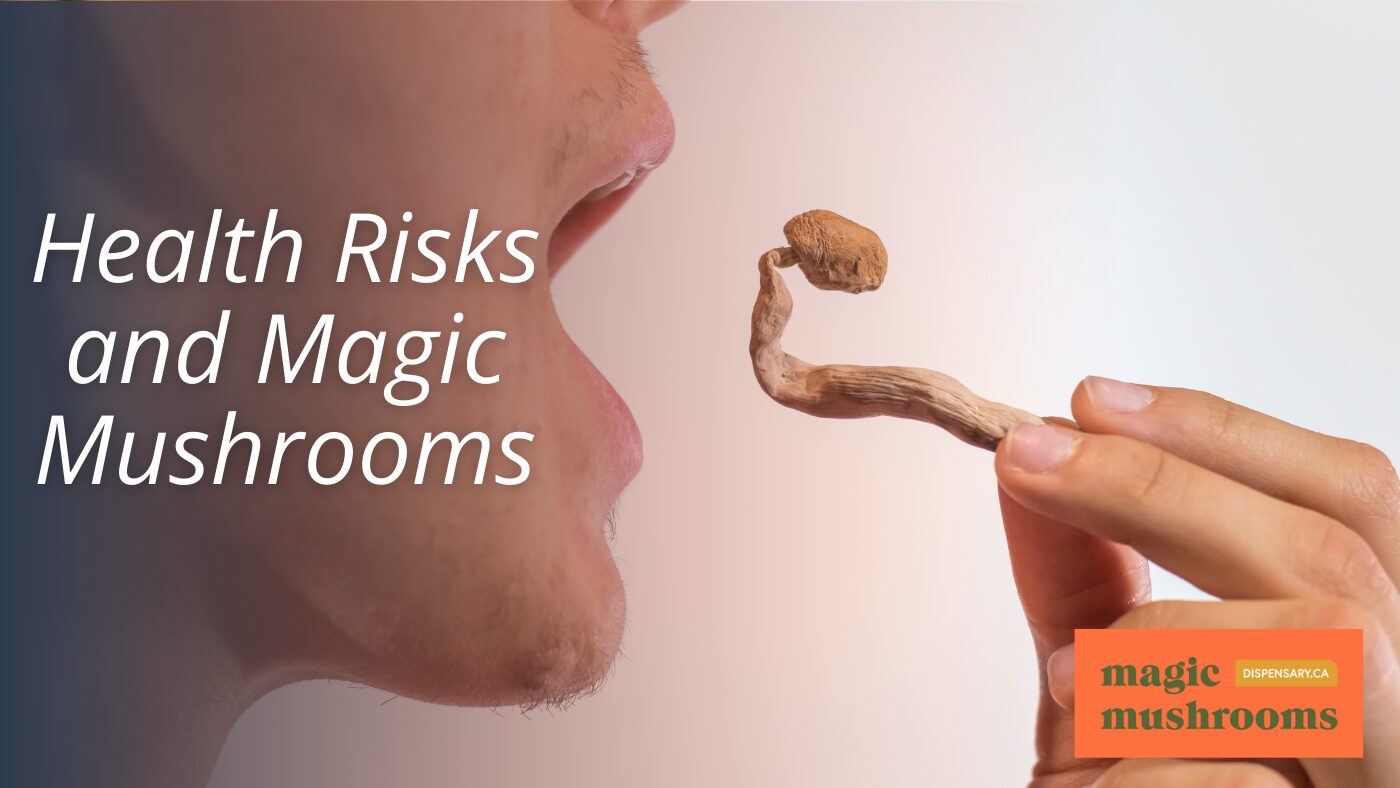
Despite the widespread use of magic mushrooms, it’s essential to understand that their consumption is not without potential health risks, including changes in awareness, heightened emotions, and even temporary psychosis. These unique fungi are known to alter perception, causing a shift in sensory experiences and a heightened sense of emotions. Some users report having a distorted sense of time and space, which can lead to disorientation or panic in unfamiliar environments.
Moreover, magic mushrooms can induce intense visual and auditory hallucinations that may be exciting for some but can also trigger anxiety and paranoia, especially in high doses. These experiences, often referred to as ‘bad trips,’ can be highly distressing and can even lead to risky behaviors due to impaired judgment.
Magic mushrooms also carry the risk of poisoning, mainly if users mistakenly consume toxic varieties, believing them to be psychoactive. Even when the correct variety is consumed, the body’s reaction to these compounds is not entirely predictable, leading to potential adverse effects.
Regular use of magic mushrooms can also result in tolerance, reducing the desired effects over time. This can lead users to consume larger doses, increasing the risk of negative experiences and potential harm.
While magic mushrooms can offer profound experiences, their use is not without risks. Users need to be educated about these potential dangers and to make informed decisions about their use. After all, understanding and respecting these powerful substances is the key to managing their use safely.
Fact: The Therapeutic Potential
Moving away from the potential risks, it is equally important to take note of the therapeutic possibilities that hallucinogenic mushrooms present, particularly in the domain of mental health. The study of psilocybin, the active compound in hallucinogenic mushrooms, has presented a new frontier in the treatment of mental health disorders. Its application in clinical settings has shown promising results in reducing symptoms of depression, anxiety, and PTSD. Unlike traditional therapies, psilocybin can potentially reset the brain and promote emotional healing.
This does not mean, however, that the therapeutic use of these mushrooms is without challenges. Consumption of hallucinogenic mushrooms outside of a controlled environment can lead to unpredictable and potentially harmful effects. Therefore, it is essential to administer these treatments in a safe and supportive setting, under the supervision of trained professionals.
The therapeutic potential of hallucinogenic mushrooms is a promising field of study. Ongoing research is exploring the efficacy of these treatments, and the early results are encouraging. However, it is vital to approach the topic with a balanced perspective, acknowledging both the potential benefits and risks.
Hallucinogenic Mushrooms Vs. Other Drugs
Exploring the complex landscape of psychoactive substances, it becomes evident that hallucinogenic mushrooms containing compounds like psilocybin stand distinct from other drug categories, such as stimulants or opioids. Unlike these substances, hallucinogenic mushrooms do not function by suppressing pain or overstimulating the nervous system. Instead, they interact with serotonin receptors in the brain, affecting mood, perception, and cognitive processes.
These mushrooms belong to the class of psychedelics, which differ markedly from depressants like alcohol or sedatives. Their effects can be profound and transformative, leading to altered states of consciousness that can inspire introspection and self-discovery. This unique attribute makes them stand apart and invites curiosity from those seeking psychological liberation.
While hallucinogenic mushrooms share similarities with other psychedelics, such as LSD, they are distinct in that they are naturally occurring. This lends them an allure for those who prefer natural substances over synthetically produced drugs. Their use spans centuries and is deeply embedded in various cultures for spiritual and therapeutic applications.
Despite their potential benefits, hallucinogenic mushrooms carry risks, like any other psychoactive substance. These risks can be mitigated through responsible consumption, guided by accurate information and respect for the substance. It is important to remember that while they offer a unique pathway to self-exploration and therapeutic potential, they are not a panacea and should be approached with caution and respect.
Myths About Mushroom Preparation
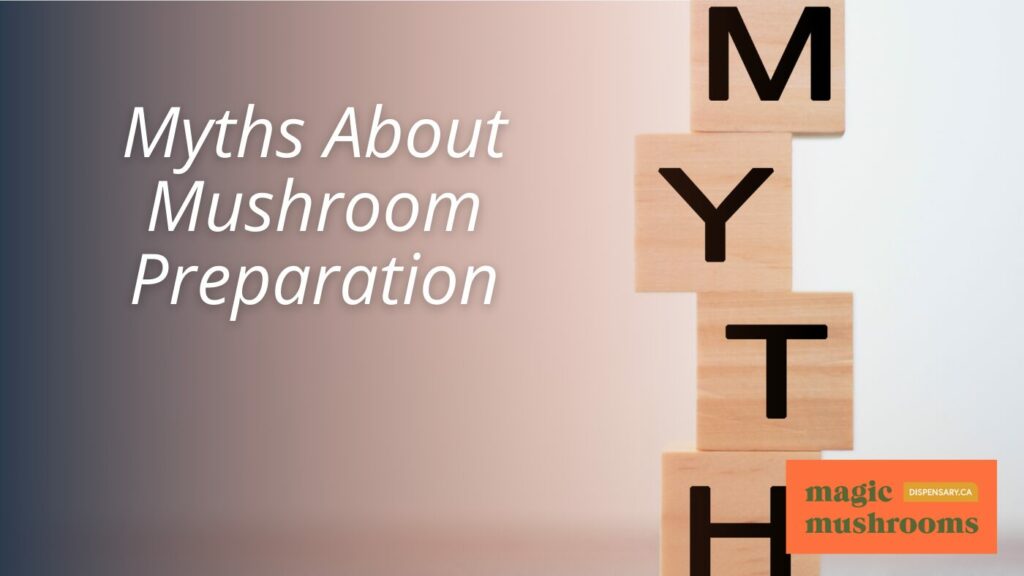
Shifting our attention from the general effects and uses of hallucinogenic mushrooms, we must address a series of misconceptions regarding their preparation and consumption. One common myth suggests that boiling these mushrooms eradicates their hallucinogenic properties. This is not accurate. Even when subjected to high temperatures, hallucinogenic mushrooms retain their psychoactive compounds and, therefore, their ability to induce hallucinations.
Similarly, drying these mushrooms is often believed to minimize their potency. This, too, is a fallacy. While the physical structure of the mushroom may change upon drying, the psychoactive components remain intact. Dried hallucinogenic mushrooms are still capable of inducing altered states of consciousness, debunking the myth that they lose their effectiveness when not consumed fresh.
Lastly, it’s essential to address the misconception that brewing hallucinogenic mushrooms in hot tea will destroy their hallucinogenic components. This belief is unfounded. The psychoactive compounds of these mushrooms are resilient and can withstand the brewing process, resulting in a tea that retains the psychedelic effects of the mushrooms.
While prevalent, these misconceptions are quickly dispelled with accurate knowledge and understanding. Education is vital in promoting safe and responsible use. By understanding the limitations and capacities of these natural substances, we can liberate ourselves from misinformation and fear, enabling a more nuanced and respectful engagement with these powerful tools of perception. It’s important to remember that responsible use is paramount for any substance that alters our consciousness, and the same holds for hallucinogenic mushrooms.
Truth About the Mushroom Trip
The truth about the ‘mushroom trip’ lies in understanding the potent compound psilocybin, which is responsible for inducing hallucinations and altered states of consciousness when consuming these magic mushrooms. This naturally occurring psychoactive compound is found in over 200 species of mushrooms, known as psilocybin mushrooms or ‘magic mushrooms.’ When ingested, psilocybin interacts with the serotonin receptors in the brain, leading to a range of perceptual changes and emotional experiences.
The effects of a mushroom trip can vary widely, influenced by several factors such as the dosage, the consumer’s mindset, and the environment in which the mushrooms are consumed. The hallucinogenic journey often begins with a sense of euphoria, laughter, and visual enhancements, followed by deeper emotional and spiritual experiences. These can include feelings of unity, interconnectedness, and profound understanding, which many have described as life-changing.
However, it’s essential to remember that not all experiences are positive. The hallucinogenic effects can also lead to episodes of anxiety, paranoia, and confusion, especially in unsuitable settings or among individuals with certain mental health conditions. Therefore, it’s crucial to approach the use of these mushrooms with respect, understanding, and caution.
Magic Mushrooms in Pop Culture
In popular culture, magic mushrooms have made notable appearances, influencing various forms of media, including film, music, television, and even fashion. These hallucinogenic fungi have been woven into the cultural fabric, serving as a substance of intrigue and a symbol of exploration into the mind’s uncharted territories.
Movies such as ‘Alice in Wonderland’ have employed the notion of magic mushrooms to depict journeys into fantastical worlds. At the same time, music icons like The Beatles have reportedly drawn inspiration from their effects for some of their psychedelic tunes. Television has yet to be immune to the allure of these fungi either, with references found in popular series like ‘Breaking Bad’ and ‘The Simpsons.’
Music festivals, such as Burning Man and Coachella, are known to have attendees who indulge in the consumption of magic mushrooms, a validation of their continued presence in the modern counterculture. Such gatherings often result in a fusion of art, music, and psychedelic experiences, creating unique shared moments of liberation and self-expression.
The influence of magic mushrooms extends even into fashion and design, with motifs of these magical fungi appearing in various artwork and clothing lines. They’ve become symbols of a subculture that values exploration, creativity, and non-conformity.
Notable figures like Jimi Hendrix and Steve Jobs, known for their groundbreaking work in music and technology, have openly spoken about their experiences with magic mushrooms. Their stories contribute to the mystique of these hallucinogenic mushrooms and their perceived ability to inspire innovation and creative thinking.
Myths About Mushroom Cultivation
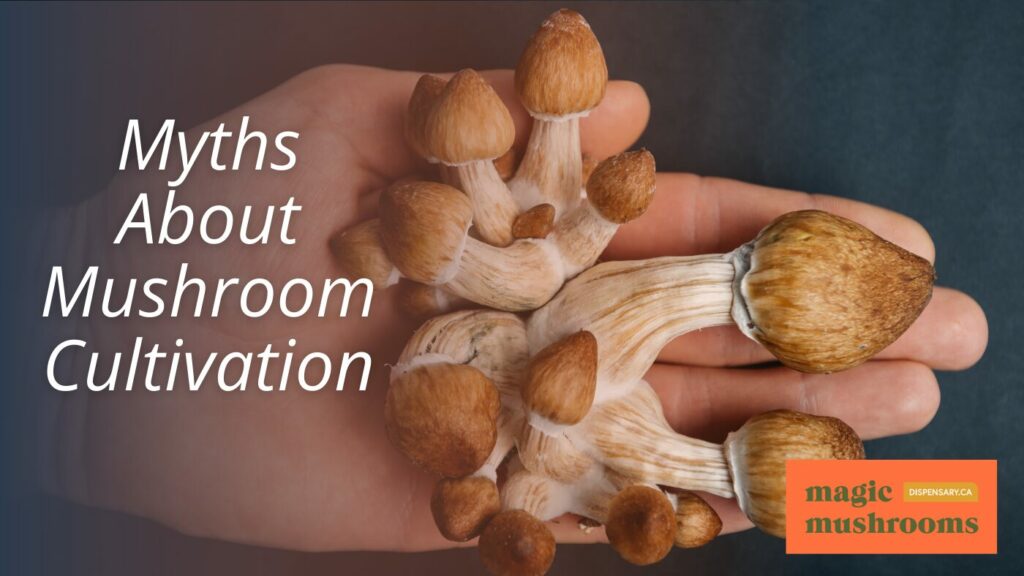
Contrary to popular belief, cultivating hallucinogenic mushrooms is a complex task surrounded by a host of myths and misconceptions. Many individuals erroneously believe that growing these fungi is an effortless hobby, requiring minimal attention and care. However, this is far from the truth. Cultivating hallucinogenic mushrooms is a meticulous process that requires accurate control of specific growing conditions, including humidity, temperature, and lighting. Therefore, it is far from the essential set-and-forget endeavor it is often perceived as.
The myth that anyone can grow hallucinogenic mushrooms at home without proper knowledge or skill is dangerously misleading. The cultivation process involves following precise steps and maintaining sterile conditions to prevent the growth of contaminants. It is not a simple case of planting a spore and waiting for a mushroom to sprout; it is a science requiring a deep understanding of the fungus’s growth and lifecycle.
Another prevalent myth is that cultivating hallucinogenic mushrooms is a quick process with guaranteed results. It is a time-consuming process that requires patience, attention to detail, and a willingness to learn from failure. The growth of these mushrooms can be unpredictable, and success is not always guaranteed, even for seasoned cultivators.
It is important to dispel these myths and promote a more realistic understanding of the process involved in the cultivation of hallucinogenic mushrooms. This will enable those interested in cultivation to approach it with the necessary respect, knowledge, and caution it requires.
The Role of Set and Setting
Understanding the role of set and setting is vital when consuming hallucinogenic mushrooms, as these factors greatly influence the user’s experience. ‘Set’ refers to the individual’s mindset, including their emotional state and expectations, while ‘setting’ pertains to the physical and social environment in which the mushrooms are consumed. Both play a significant role in shaping the subjective experience of the user.
Psychonautical research has shown that a positive set and setting can enhance a hallucinogenic experience, leading to more beneficial outcomes. Conversely, a negative mindset or a stressful environment can lead to an unpleasant or even traumatizing experience, often called a ‘bad trip.’ Therefore, users must carefully consider their mental and physical preparedness and ensure they are comfortable, safe, and supportive.
Moreover, setting intentions before the journey can also prove advantageous. This means having a clear purpose for the experience, such as self-discovery, healing, or spiritual growth. Additionally, having a trusted individual, often called a ‘trip sitter,’ present during the experience can provide safety and reassurance. This person can help manage any potential difficulties and provide support when needed.
Fact: The Potential Risks
Despite their therapeutic potential, hallucinogenic mushrooms carry an array of potential risks, including paranoia, anxiety, and unpredictable behavior. These substances are potent and can alter perception, mood, and thought processes to a great extent, often leading to experiences that may be overwhelming or distressing for some.
Hallucinogenic mushrooms are not inherently harmful, but their effects can be challenging for those unprepared for their powerful impact. The effects can be unpredictable, varying widely based on dosage, individual sensitivity, and the specific type of mushroom consumed. This unpredictability can result in experiences that induce significant psychological distress, particularly for inexperienced users. Hence, it is essential to approach the use of these substances with caution and respect for their potential effects.
Furthermore, the risk of misidentification when foraging for mushrooms in the wild is high, which can lead to ingesting toxic and potentially lethal mushroom species. This underscores the importance of obtaining hallucinogenic mushrooms from reliable and knowledgeable sources to avoid accidental poisoning.
Myths About Mushroom Dosage
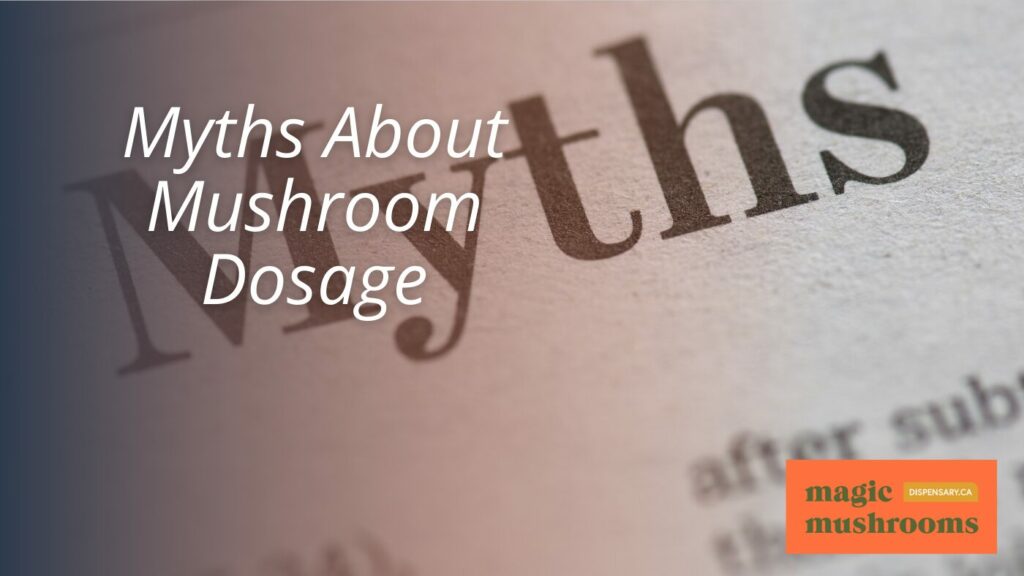
In the domain of hallucinogenic mushrooms, there exist numerous myths and misconceptions about dosage, often leading to potentially dangerous misuse. These inaccuracies not only jeopardize the safety of users but also hinder the progressive understanding of these natural substances in therapeutic and cultural contexts.
One common myth is that eating a small amount of hallucinogenic mushrooms won’t cause any effects. This is a dangerous misconception. Even modest doses can induce hallucinations and altered perceptions. Thus, anyone seeking to explore the potential of these mushrooms must approach them with respect and caution, starting with a smaller dose and gradually adjusting based on personal tolerance and response.
Another widespread myth is that consuming a large amount of hallucinogenic mushrooms guarantees a more substantial trip. This is also misleading. The intensity of the experience can vary depending on individual factors like metabolism, tolerance, and environmental conditions. Ingesting a larger quantity does not necessarily translate to a more profound understanding.
The most challenging myth is the belief that consuming more hallucinogenic mushrooms than recommended will lead to a more intense experience. Overdosing on these substances can trigger severe physical and psychological effects, including poisoning and psychosis. This underscores the importance of responsible usage, emphasizing that more is not always better.
Countering these myths is essential for the safe and enlightened use of hallucinogenic mushrooms. Users should seek reliable sources of information, engage in harm-reduction practices, and approach these substances with an educated understanding of their potential effects and risks.
The Truth About Bad Trips
Shrouded in misconception and fear, ‘bad trips’ from hallucinogenic mushrooms are a reality that can manifest as intense paranoia, anxiety, and confusion. These experiences are not the norm, but they do occur, often as a result of factors such as high dosage, a hostile environment, or a fragile mental state.
While hallucinogenic mushrooms have been used traditionally and medicinally for centuries, they are powerful substances that can provoke profound psychological reactions. The likelihood of a ‘bad trip’ can be amplified if the user consumes a large dose, is in a stressful or unfamiliar environment, or is dealing with underlying mental health issues.
However, a ‘bad trip’ does not signify a permanent state of distress. It is a temporary condition, albeit one that can be deeply unsettling. The key to managing such situations is to create a calm and supportive environment and seek medical assistance in extreme cases. It’s important to remember that these are not permanent alterations to one’s mental state but temporary reactions to the substance.
Understanding the potential risks associated with hallucinogenic mushrooms, including the possibility of a ‘bad trip,’ is essential for anyone considering their use. By being informed about dosage, set, and setting, individuals can make knowledgeable decisions, mitigating risks and fostering safer experiences.
In the pursuit of liberation, education, and awareness are fundamental. Dispelling myths and misconceptions about hallucinogenic mushrooms and ‘bad trips’ can lead to a more enlightened and responsible approach to their use.
Hallucinogenic Mushrooms and Creativity
Exploring the relationship between hallucinogenic mushrooms and creativity reveals a fascinating interplay. Historical and contemporary reports suggest these natural substances can significantly enhance artistic expression and cognitive flexibility. The active compound in these mushrooms, psilocybin, is known to alter perception, potentially boosting creativity. Hallucinogenic mushrooms have been associated with increased creative thinking, the generation of novel ideas, and artistic inspiration.
Research supports these anecdotal reports, suggesting that psilocybin can increase neural connectivity and promote divergent thinking. This enhancement of cognitive function can lead to creative breakthroughs, providing new ways of perceiving and interacting with the world. The substance allows users to break free from conventional thought patterns and explore new territories of creativity.
Moreover, the consumption of hallucinogenic mushrooms can encourage unconventional problem-solving approaches. By shifting perspectives and promoting novel viewpoints, these mushrooms foster creative exploration. This shift can be particularly beneficial in fields that value innovation and out-of-the-box thinking.
Educating oneself about the effects, dosage, and potential risks associated with hallucinogenic mushrooms is essential for responsible use. While these natural substances can significantly enhance creativity, it’s important to remember that they also have potential risks. Hence, it’s essential to navigate this journey with knowledge and respect.
Fact: The Future of Psychedelic Research
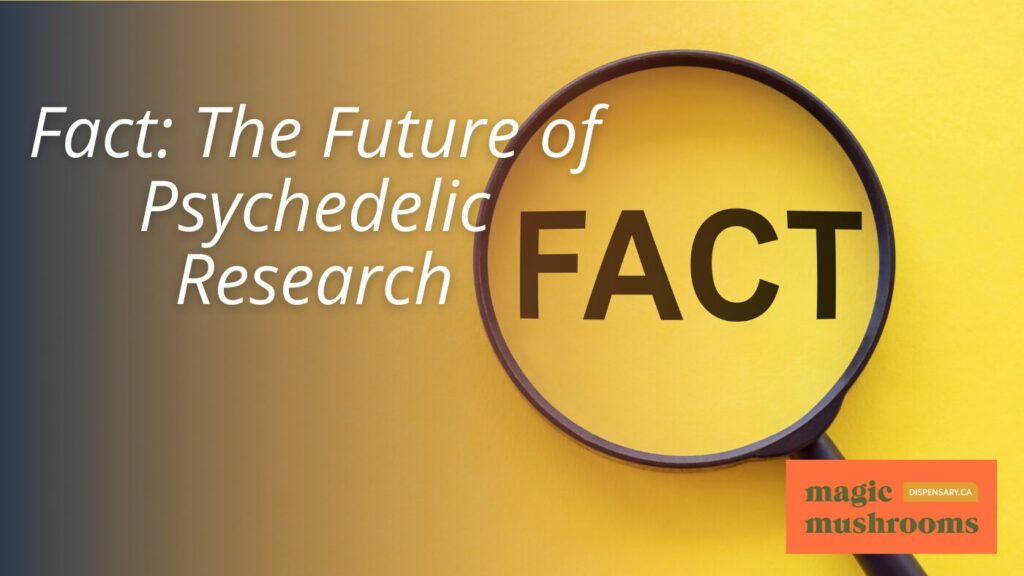
As we broaden our understanding of hallucinogenic mushrooms and their potential to enhance creativity, it’s equally important to recognize the expanding field of psychedelic research that goes beyond these traditional substances. This scientific domain is venturing into uncharted territories, exploring new compounds, and identifying novel receptors to comprehend the full potential of psychedelics.
The future of psychedelic research holds immense promise, particularly in the sphere of mental health treatment and personal transformation. Recent studies have suggested the possible benefits of these substances in treating conditions such as depression, anxiety, and post-traumatic stress disorder. The potential of psychedelics extends beyond therapy, with many individuals reporting profound personal and spiritual growth experiences.
However, the industry knows the possible risks and moves towards responsible advancement and discovery. The goal is to guarantee safety and efficacy while tapping into these substances’ therapeutic potential. This includes rigorous clinical trials, public education, and policy reforms that balance the benefits against potential harms.
The momentum for psychedelic research is only growing, with increasing investment in studies aiming to understand these powerful substances better. The motivation behind this push is not just scientific curiosity but a desire to free people from the chains of mental illness and to enhance human potential.
Conclusion
As knowledge unravels the shroud of mystery enveloping mushrooms that cause hallucinations, the caricature of danger fades. The veil of misconceptions lifts, revealing a panorama of therapeutic possibilities and creative exploration. Nonetheless, it is vital to navigate this domain cautiously, understanding the species, dosage, and potential risks. The future of psychedelic research holds promise, but only with balanced, informed practices will we truly harness the potential of these enigmatic fungi.
Buying Microdosing Mushrooms Online in Canada
Are you an avid microdoser or looking to venture into the art of microdosing? Working with a reliable, trustworthy shrooms dispensary is paramount in becoming a better version of yourself. Magic Mushroom Dispensary prides itself on its comprehensive collection of top-notch microdosing products, psilocybin books, excellent customer service, and fast, discreet shipping. Visit our online shop today and enjoy low prices and free shipping for orders above $99.
Originally posted on June 30, 2024 @ 9:57 am
